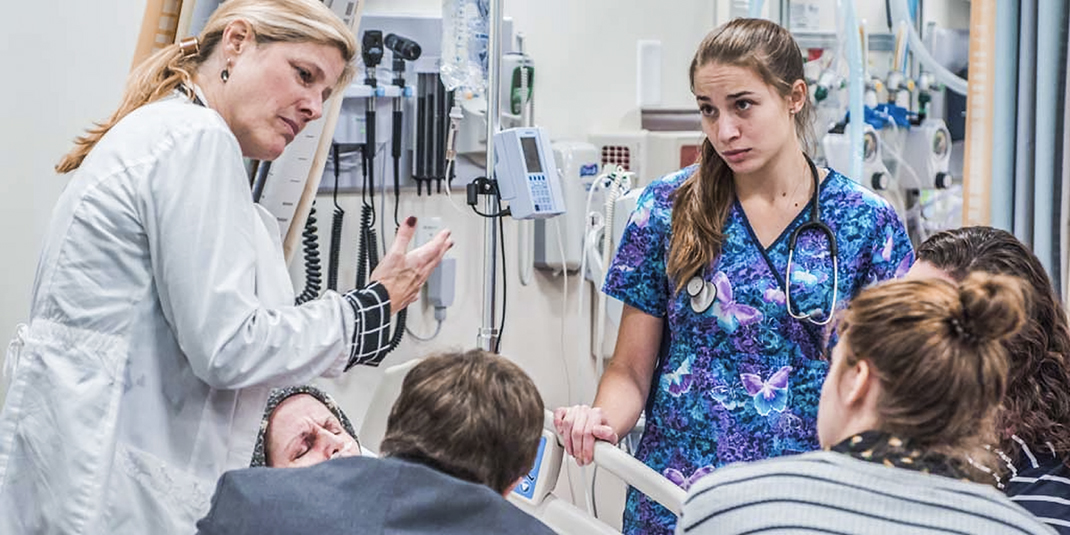Throughout the semester, senior nursing students came to know ‘cancer patient’ Marybeth McManus. On the final day of class, she had minutes to live.
For the third time in four years, Eileen Sullivan will die in front of her students from the Connell School of Nursing. December 6 is the appointed date, the last day of the semester-long End of Life Simulation Program for seniors. Sullivan, the 55-year-old assistant director of the school’s learning laboratories, is reprising her role as Marybeth McManus, an ovarian cancer patient, and at approximately 10:50 a.m. Marybeth will take her final breath, surrounded by hospice nurses and members of her family. It is the end-stage, and doctors have stopped intervening. At this moment, however, 8:40, Sullivan is stuck in traffic.
Inside the Connell School’s Brown Family Clinical Learning Laboratory, a simulation facility on the second floor of Maloney Hall, clinical assistant professor Amy Smith is preparing the scene. With 2,000 square feet of open space, the lab—equipped with crash carts, EKG machine, electronic medication systems, and much else—can be subdivided by curtains into 12 hospital rooms. Smith needs to create one that will accommodate a seated audience of 24 students and faculty. A veteran midwife, buoyant and empathetic, she seems at first an unlikely candidate to develop a course on death and dying. But she has a doctorate in nursing simulation from the Massachusetts General Hospital Institute of Health Professions, and has spent the last nine years as the Connell School’s director of clinical learning and simulation. She has designed, staged, directed, cast, and secured funding for highly realistic replications of the nursing experience, with productions focused on guiding first-time mothers through delivery and on treating substance abusers, diabetics, schizophrenics, and victims of violent crime and natural disaster. For a psychiatric nursing simulation, Smith played an enraged mental hospital patient who attempted to kill her husband and refuses her medications. For “Nursing Synthesis,” she played a stern and tactless physician whose visit leaves nursing students to mediate and to soothe their patient. In every simulation, says Smith, “There’s an unwritten rule: Never let the patient die. The learning shuts down when it becomes traumatizing.” Today, after three months preparing the students, that rule will be broken.
This morning Smith left her house in Kennebunkport, Maine, at 4:00, as she does each workday, and since 6:00 she has been busy filling a morphine drip bag with water (a nurse will pretend to insert an IV into Marybeth’s arm), dialing in the oxygen flow for Marybeth’s nasal tubing on a wall-mounted gauge, adjusting the hospital bed Marybeth will lie on, and arranging framed photographs of Marybeth’s family on a hospital nightstand. Smith has even brought a floral-patterned quilt from home—patients who have spent serious time in the hospital often do that. The more realistic, the more memorable, she says.
At 8:50, Jeanie Foley-Kass, WCAS’05, MS’08, walks in. The assistant director of the simulation lab, with a silver pixie cut accented by a lightning bolt of purple dye, Foley-Kass is also the nursing school’s resident artist for moulage, the practice of applying grisly makeup for added realism in trauma training. As she waits for the death scene’s six actors to arrive, she says to me, “Let me show you my burns. I’m pretty proud of them.” Holding her phone she swipes through photographs from the previous day’s simulated disaster, a chemical explosion in an office building for “Population Health”—shots of five undergraduate women with lacerations on their arms, bloodied foreheads, and third-degree burns on their legs, each wound concocted from fake blood, cornstarch, varieties of makeup, and Vaseline.
In the lounge outside the entrance to the soundproof laboratory, students in maroon scrubs begin to gather, occupying the tan benches and armchairs, quietly chatting and sharing notes for pending final exams in other classes. Over the span of the semester, these 21 seniors have studied how to work with end-stage patients in hospice, palliative, intensive, and pediatric care settings. They also have followed Marybeth and the progression of her disease through a series of videos. The fifth and final video was shown two weeks ago. They’ve known since September that she will die today.
Inside the lab, a jocular, reunion-like mood pervades as Marybeth’s family and healthcare providers, acted by faculty and alumni volunteers, arrive. When Sullivan walks in at 9:35—through the back door, so students won’t see her—she says, “I should probably take off my Fitbit.”
“You’re not going to be getting many steps where you’re going today,” says Foley-Kass.
The jokes end once Sullivan removes her earrings and changes into a thin, wrinkled hospital gown, white with pale blue dots. Foley-Kass grabs a makeup bag and leads Sullivan into one of the lab’s five exam rooms to turn her into a cancer patient one hour from death.
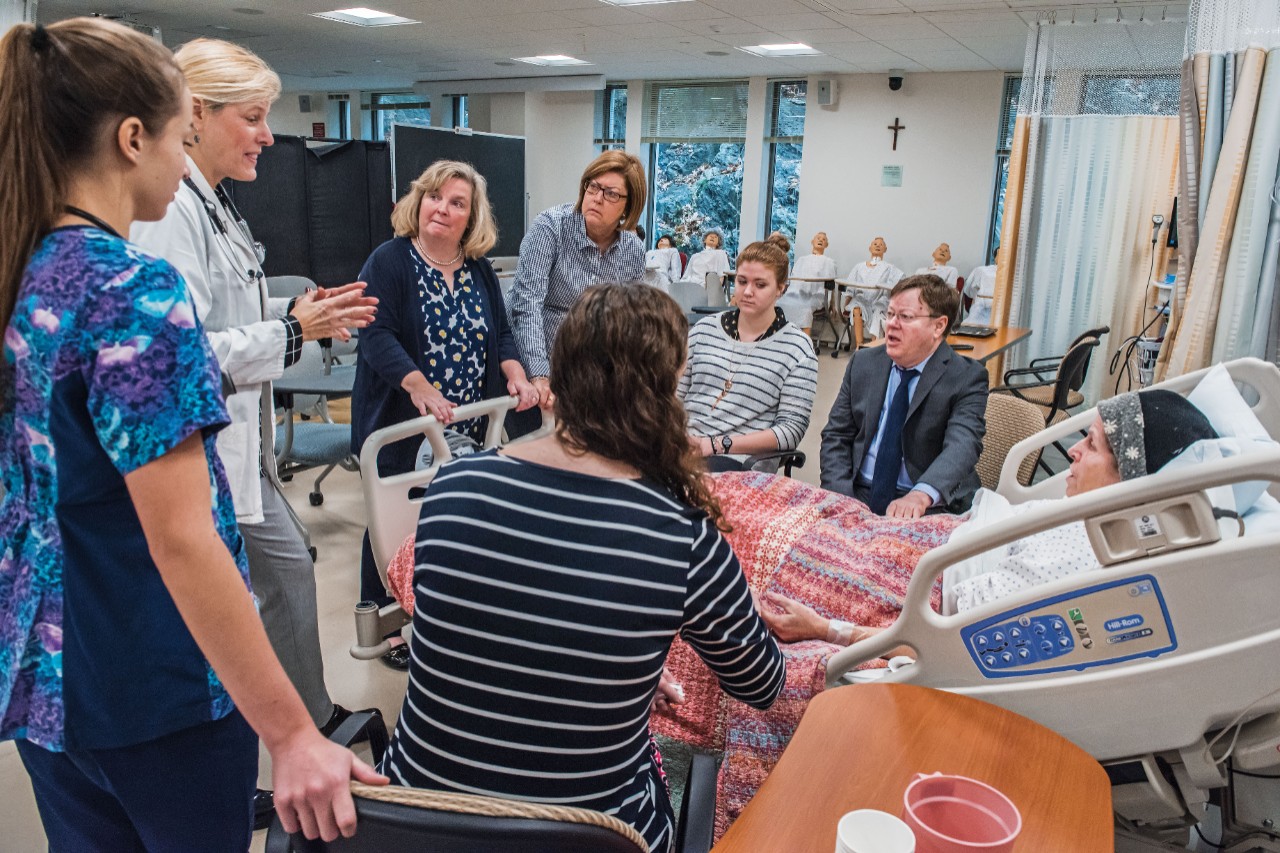
A conference before the students arrive. Clockwise from left: Contino (in floral scrub), Zlevor, Smith, Cullinan, Lawler, Ross, Sullivan, and Gribaudo.
Amy Smith developed the End of Life program in 2013, her fourth year teaching at Boston College. In discussions with dozens of faculty members and the nurses who train Connell students in Boston-area hospitals, and in exit interviews with graduating students, she asked what they thought were the unmet needs in the nursing curriculum. Nearly everyone said that students were not sufficiently prepared for dying patients.
It’s a feature of modern medicine that “we always want to fix, fix, fix,” explains Smith, who notes that nurses spend the majority of their careers “saving, improving, and prolonging lives.” Doctors, nurses, patients, and patients’ families alike come to view death as the ultimate failure. And yet, 80 percent of Americans die in healthcare settings. And 87 percent of current nurses have cared for a dying patient in the past 12 months. Studies in the Journal of Nursing indicate that a patient’s death can propel a nurse into anxiety, anger, feelings of impotence, or, worse, “compassion fatigue.”
Like the vast majority of bachelor’s and graduate nursing programs in the country, the Connell curriculum long tucked death sparingly into a handful of courses—an hour on stillbirth in “Childbearing Nursing Theory,” a reading on hospice in “Adult Health II.” Smith found no model for an undergraduate course devoted to dying. To build one, she assembled a team of six faculty and alumni nurse practitioners. These included clinical assistant professor Donna Cullinan, MS’99, who in 2011 developed the annual nursing service trip to Léogâne, Haiti; Harriett Nelson, a lecturer at Boston College and a pediatric critical care transport nurse at Boston Children’s Hospital; and clinical associate professor Susan DeSanto-Madeya, an award-winning palliative care nurse scientist and practitioner at Beth Israel Deaconess Medical Center.
DeSanto-Madeya articulates a central tenet of the program as it has emerged. An End of Life program, she says, should prepare students to “be alert to what nurses often overlook: psychosocial and spiritual needs, not just of the patient with a serious illness, but also of the entire family affected by it.” That’s been a key message, say students. Margaret LaNasa, a senior from Pennsylvania, told me about the “universal face” of poise and placidity that nurses learn to assume when delivering urgent care. She had been working three days a week since the spring of her junior year as a patient care assistant on an oncology floor at Newton-Wellesley Hospital, and she made the point this way: In the “switch from trying to save a life to making the remaining days worthwhile living, you can support someone’s soul even when you stop intervening to help the body.” Fellow senior Nick Raposo, an aspiring labor and delivery nurse from Fall River, Massachusetts, calls this “being human.” Raposo lost his father when he was a senior in high school. The program, he says, has “helped me realize I will be a better nurse because I’ve experienced loss. I recognize now that when I was grieving, the most helpful people were those who were attentive and present and anticipated my needs without me saying anything. All of those things I can do for my patients.”
In early 2014, Smith and Cullinan submitted a proposal, “Death and Dying with Dignity: Using Simulation to Teach Nursing Students the Art of Caring,” and received a $12,500 Teaching, Advising, and Mentoring grant from the provost’s office. The following fall, the End of Life Simulation Program became a requirement for Connell School seniors, and it remains so.
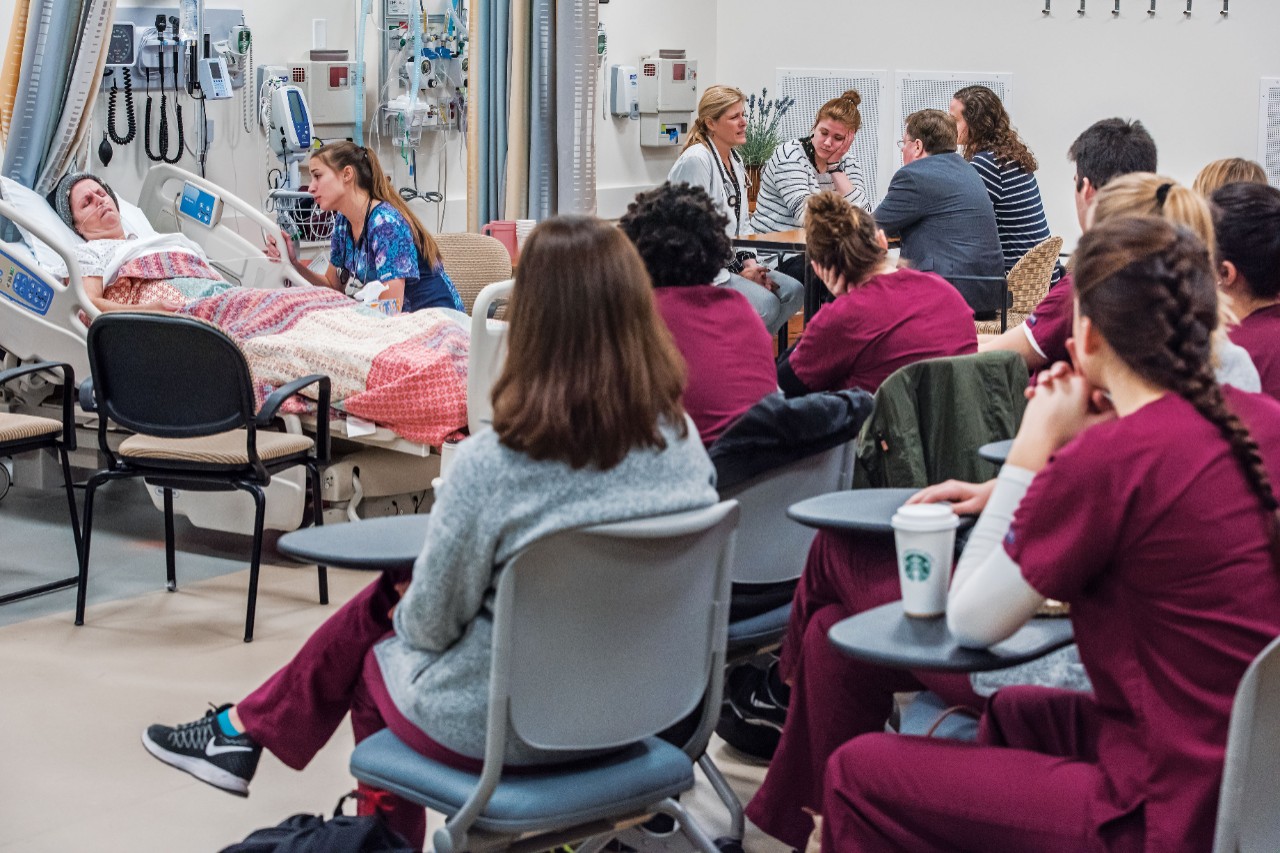
Zlevor consults with Marybeth’s family (upper right) as, at left, Contino monitors the patient
Over 14 weeks, through videos, readings, writing assignments, and clinical rotations, the seniors study the many facets of end-of-life care. They learn the technical side—the effects and suitable dosages of morphine and fentanyl for managing pain, the clauses of the 1981 Uniform Determination of Death Act (a federal enactment, and essentially a recommendation; states set the standards for moment of death). They learn the primary causes of death for children ages zero to one (SIDS and genetic conditions), one to four (accidents and genetic conditions), and five to 14 (accidents and cancer). And they learn how to communicate with patients and their families on the topic of death: When explaining an illness, speak softly, slowly, and plainly. Ask often if the patient and his or her family understand. Embrace long pauses, and avoid medical jargon and euphemisms, call death by its name. Listen. When discussing protocols such as DNR (Do Not Resuscitate) and MOLST (Medical Order for Life-Sustaining Treatment), don’t ask, “If your mother’s heart stops, do you want us to use CPR to restart it?” Rather say, “When a patient in your mother’s condition reaches the end of life, aggressive measures like CPR are not effective and can cause distress. We recommend no attempts at resuscitation.” Students watch the grueling 30-minute instructional video The Deafening Silence: Stillbirth Through a Mother’s Eyes, which shows one young woman suffering through denial (insisting to her nurse that she can feel her deceased fetus kicking), anger, then inexplicable guilt, hysterically repeating “This is my fault.” The film presents examples of both insensitive nursing (one nurse tells the woman, “You’ll have to come back tomorrow [for a bed]; we need to give priority to those who are giving birth to live babies”) and of compassionate nursing, demonstrating how to gently encourage parents to hold their stillborn baby before the body is carried away. Parents who don’t see their child, studies show, regret it. Says Smith: Offer them a moment “to validate that life.”
To understand the particularities of traumatic death, the seniors watch a series of video interviews Smith conducted with emergency room nurse Melissa Mullen ’96, in which Mullen recounts treating a pilot who crashed his single-engine plane and was rushed to her hospital. By the time he was lifted out of the ambulance, she says, “he had coded”—his breathing and his heart had stopped. A phalanx of nurses, surgeons, patient care assistants, and an attending physician working together in a curtained-off space couldn’t resuscitate him, and time of death was called for the man, referred to in that moment as “unknown male trauma patient.” Then everyone except Mullen and a surgical resident left the area. “After your adrenaline was so high,” says Mullen, “it completely crashes down, and you’re left to deal with the body that’s on the table.” As she removed tubes and scrubbed off his dried blood, another nurse entered to say that the man had a wife and two young children, and that the wife had arrived, insisting she see the body. “Suddenly, the man before me became very real,” says Mullen, and she hurried to “stage” the scene; she mopped the floor, closed the man’s mouth, placed a pillow beneath his head, washed his wedding ring, still on the finger of his broken hand, and dimmed the lights so he might appear to be resting. Mullen greeted the wife outside the curtain, and warned her that her “husband wasn’t going to look like he did this morning when he left for work.” The moment Mullen showed her in, the wife fell to her knees, weeping. Two days later, the team who had worked on the patient debriefed for an hour and a half, rethinking protocols and sharing feelings of guilt, grief, and confusion. Mullen’s eyes well up, and she notes for the camera that it has been 13 years since that day in the emergency room.
“We want students to be aware that many of their patients will stay with them,” said DeSanto-Madeya later, “and that self-care is crucial to surviving and growing as a nurse.”
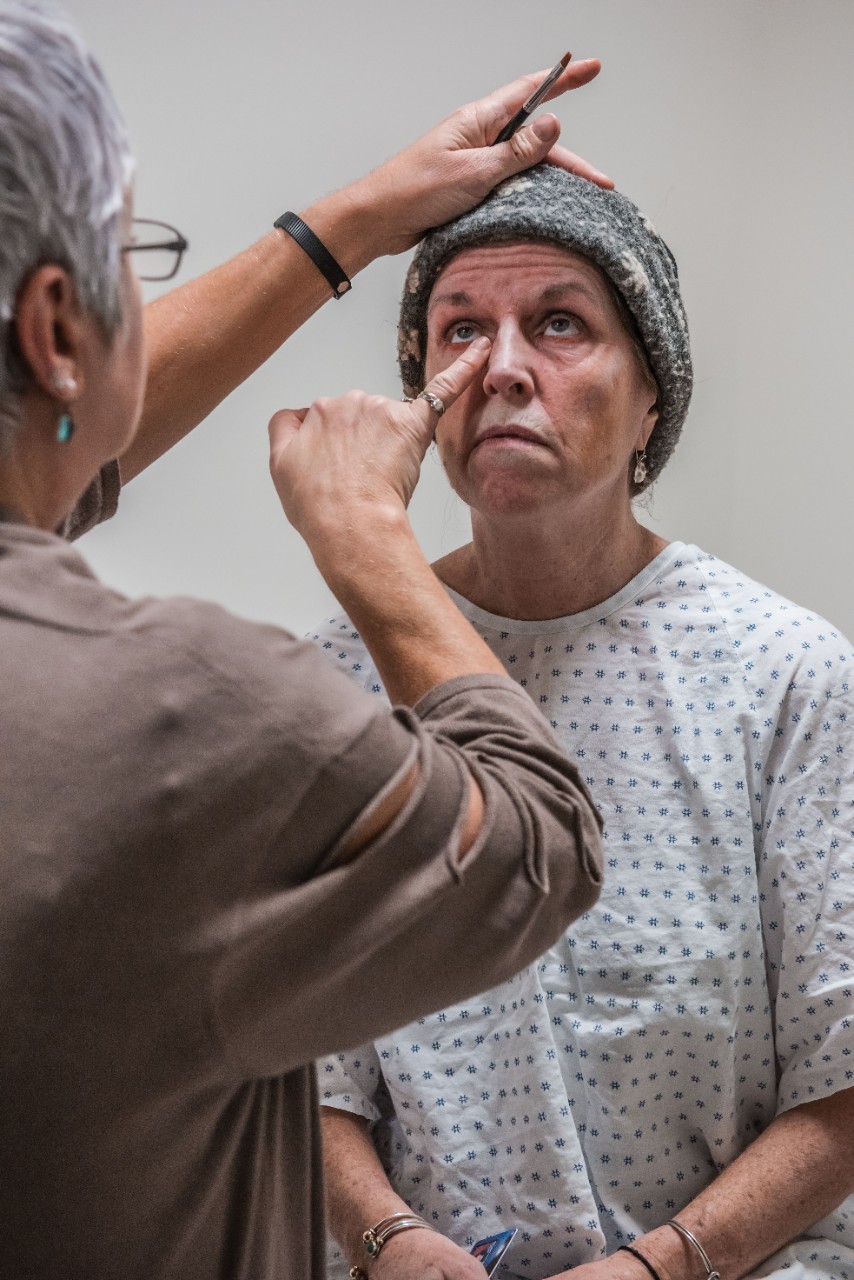
Foley-Kass applies moulage to Sullivan
In the Maloney Hall exam room on December 6, Foley-Kass sets eye-liner, blush, lipstick, and powder on a medical supplies cart, along with her cellphone, which displays a photo of a corpse from a recent vampire movie. Sullivan sits on the exam table and the moulage artist applies gentle brush strokes to her nose and cheeks and pale, translucent lipstick. “Burns are a complicated Play-Doh. Death is just contours and shadowing,” says Foley-Kass. Within 10 minutes, Sullivan’s bright, freckled face is mottled with small, brown patches of dead, encrusted skin tissue that can forewarn the end of life. Her cheeks are gaunt, her complexion pallid and chapped. Sullivan stays mostly silent as Foley-Kass works. She’s meditating, she says later, on a childhood friend who recently died of cancer.
Through most of the 20th century, nursing students learned skills in lecture halls or by practicing on patients. They gave their first injections to the sawdust-filled Mrs. Chase doll (created in 1911 by a Rhode Island toy manufacturer) or to oranges, as recommended (for reasons unexplained) in the widely employed textbook Teaching in Schools of Nursing: Principles and Methods (1946). In the 1960s, computerized mannequins such as the anesthesia simulator Sim One, who had a heartbeat and blood pressure, were developed. But only in the 1980s, according to the journal Medical Education, did nursing schools start to incorporate simulation widely, as physicians began to delegate increasingly advanced responsibilities to nurses and nurse practitioners. Studies from the National Council of State Boards of Nursing and in the Journal of Nursing Education have found that, compared with control groups, students who practice and witness simulations show greater competence in a range of situations, from treating sepsis, seizures, and strokes, to responding to codes. Anecdotally, Tyler Thurlow ’18, a native of Philadelphia, described for me his experience with a dying patient, before participating in the End of Life program. The previous summer, while working as a patient-care technician on a cardiac-surgical floor at Beth Israel, he’d sat with an 85-year-old man dying from multi-system organ failure. “I was terrified of saying the wrong thing, not being able to say anything at all, or that he would die on me,” he said. The patient himself calmed Thurlow as he thanked the nurses for their support and began to talk about his experiences in military service, his marriage to his first wife, the birth of his daughter. “He was coming to terms with the life he had lived,” said Thurlow.
For the End of Life program, Smith determined to show students “a patient throughout her journey, so that by the time she lies in that bed before them, they know her.” (In fact, many already knew Sullivan, having taken her “Nursing Health Assessment” and “Adult Health I” courses as sophomores. “Because they have memories of me even before they see me as a patient, my hope is that they feel the loss on a personal level,” says Sullivan.) Smith, Cullinan, and DeSanto-Madeya wrote a loose script for the video portions of the simulation, which they shot over three days and edited into 10-minute segments.
In the first segment, sent to students six weeks before the final, live simulation, a title card introduces Marybeth McManus, 45 years old, married, the mother of 22-, 12-, and 10-year-old daughters. A montage follows: Marybeth groaning and clutching her lower side at her desk, at the vending machine, on the stairs. “Marybeth has been having some abdominal discomfort and bloating for six months,” reads a caption. “She thought she would wait for her scheduled exam to be evaluated.”
There’s a home-movie quality to the production. The camera is often hand-held, the zoom-ins are a beat late, and occasionally the frame is blocked by an actor’s back. But the emotions over the five episodes, especially from Sullivan, are palpable—raw shock, confusion, hope, despair, fear. Watching the videos, says Raposo, “I’m in there.”
The first video cuts quickly to Marybeth’s visit to her primary care physician, acted by Smith. As the patient describes her daily pain, gastrointestinal symptoms, and family history of ovarian cancer, she abruptly stops and says softly, “Why did I wait so long?”
“You’re here now, and we’re going to get some answers,” says Smith, leaning forward to touch Marybeth’s hand.
“Watching that from my laptop in Hillside Café, I wanted to yell at Marybeth for waiting,” says Catie Trausch ’18, a native of Portland, Oregon, whose mother succumbed to cancer a year and a half ago. Trausch found Smith’s sympathetic response and “read” of the patient’s emotions enlightening.
In the second video, sent to the students a week later, Marybeth sits in her living room and takes a phone call from her doctor, who asks her to visit, with her husband, the next morning. Over an unbroken five-and-a-half-minute take, Marybeth and her husband, Richard, acted by clinical nursing instructor Richard Ross, SJ, STL’11, M.Div.’11, sit facing each other on the couch as they seesaw between dread (“It can’t be good that they’re asking you to come in tomorrow, too,” says Marybeth) and hope—”You have been feeling better the past couple days,” says Richard.
In the doctor’s conference room, Smith takes Marybeth’s hand and says carefully, “I’m concerned.” She reveals that Marybeth has invasive ovarian cancer.
The couple are speechless. Sitting next to Smith is a palliative care nurse practitioner, portrayed by Harriett Nelson. She leans toward the couple and says she’ll be assigned to their case to help manage pain, and “depending on what we find from the biopsy, help you and your children cope and get through this.” Marybeth’s husband cuts her off.
Richard: How long do you think this will take to go through the treatment?
Marybeth: Just let her talk, Richard.
Nelson: No, it’s perfectly fine. We welcome all of your questions, and that’s what we’re here for.
In segments three and four, students watch Marybeth break the news to her mother, portrayed by local family nurse practitioner Kat Tremblay, and to her daughters, who huddle in a circle in the family’s living room, crying. Marybeth appears hopeful in a scene at fictitious St. Ignatius Hospital (filmed in the Connell simulation lab), laughing with another patient who is also undergoing chemotherapy treatments. The final video opens back in the living room. Trying to stand up from the couch, Marybeth cries out and collapses. She is rushed to St. Ignatius.
Dr. Smith sits on the edge of the hospital bed and takes Marybeth’s hand again. “I have some difficult news to share with you. All the tests, bloodwork, and imaging have shown that despite our best efforts your cancer has progressed. And I’m afraid at this point we’ve exhausted all of our treatment options.”
After a pause, Marybeth asks what to do now.
“We want to help you live your days as you want to and as your family wants to,” says Smith.
Fade out, fade in to the family gathered around Marybeth in her hospital room.
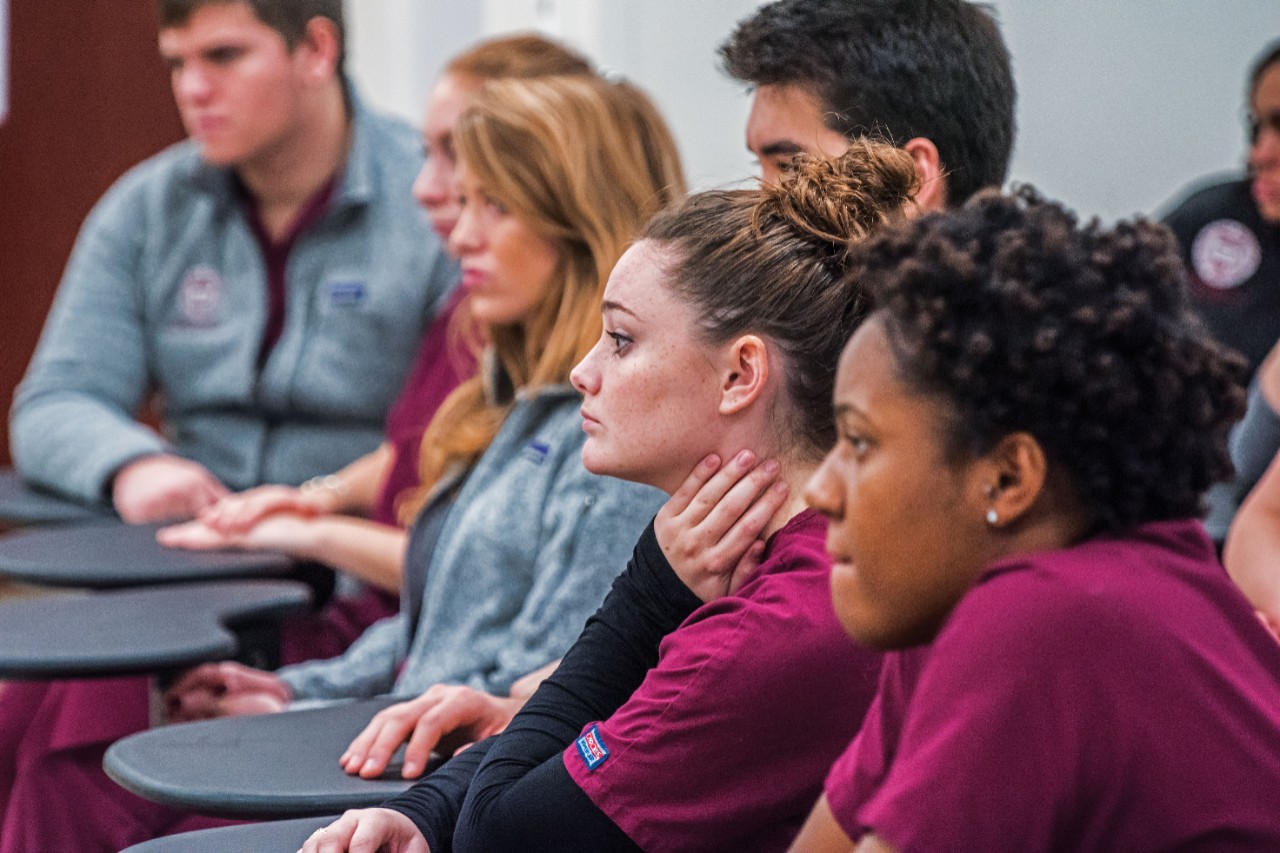
From left: Seniors Joshua Lacey, Gabriela Rufo, Kristen Maclean, Jeffrey Powell, Shea North, and Ali Jean-Pierre.
At 10:30 a.m. on December 6, students file into the lab and sit in desk-chairs aligned before a striped yellow curtain. As requested, they’ve left notebooks and laptops behind. A few sip coffee. A piano and violin recording of “On Eagle’s Wings” can be heard faintly from behind the curtain.
Smith, wearing a blue-and-yellow-floral blouse and navy cardigan, stands in front of the small audience and says, “Never forget the power of compassion. Never forget the power of touch, and the power of truly being present. You’ve been following Marybeth throughout her journey. Today we welcome you . . . for the last time.”
She pulls back the curtain to reveal Sullivan in her hospice bed, the floral quilt pulled up to her chest, thin oxygen tubing resting on her upper lip, a gray-black winter cap tucked down to her earlobes, the same hat she wore after chemotherapy in the videos. Her eyes are closed, her breathing labored and guttural. The source of the music is a small speaker on a nightstand. Alie Contino ’14, MS’18, in patterned blue-and-purple scrubs, checks her vital signs. (Contino is a nurse on a medical floor at Brigham & Women’s Hospital and a teaching assistant at the simulation lab, as she earns her nurse practitioner degree in gerontology). The patient is otherwise alone in the room.
A palliative care nurse practitioner, portrayed by Anne Zlevor, MA’08, MS’11, a hospitalist at Vibra Hospital of Western Massachusetts, walks in wearing a white coat, asks Marybeth how she’s feeling, and then asks, “Are you afraid of anything?”
“I’m afraid.” Marybeth pauses. “Of the pain because it’s so bad. And I’m afraid of being alone.”
Zlevor tells Contino to administer two milligrams of morphine every two hours, and a milligram of Ativan, for anxiety, every four.
Leaning over Marybeth, Zlevor says, quietly and firmly but with compassion, “You’re in end-stage ovarian cancer, and you’re dying. Do you know you’re dying?”
Marybeth shakes her head, barely. No.
“You’ve been an amazing mother, an amazing wife. You won’t be alone.”
Most students in the audience are learning forward in their chairs. Some nod at Zlevor’s message to her patient.
“I see you’re holding rosary beads,” Zlevor says. “Is your faith important to you?”
“My faith has carried me to this point today,” Marybeth whispers.
“God is with you,” says Zlevor. “Loved ones who have gone before you are waiting with open arms. Your body has just given up, but your spirit will continue.”
Early in the program, Smith instructed students to support the faith of their dying patients. A “good death,” as much as there can be one, she says, begins with the “most important question we can ever ask a patient: What’s important to you?”
Marybeth’s husband, sister (Amy Gribaudo, MA’15, the Connell School’s assistant director of undergraduate programs), and oldest daughter (Jillian Lawler ’15, an oncology nurse at Memorial Sloan Kettering Cancer Center in New York City) walk in and sit on either side of the bed. As Richard, in tears, whispers to his wife, Marybeth’s daughter asks, “Is the morphine killing her?”
“No. That’s a great question. But the morphine is only managing her pain,” says Zlevor. “It’s the cancer that’s killing her.”
Zlevor invites the family into another scene, at a table 10 feet from the bed, laid out with water glasses, tissues, and a bouquet of tulips. Over the sounds of Marybeth’s slow, strained, rattling breaths, Zlevor tells them Marybeth has minutes to hours to live. Husband, daughter, and sister struggle to accept her words, and several in the audience are crying, including Susan DeSanto-Madeya and Donna Cullinan.
When the family returns to the bedside, Lawler strokes Marybeth’s hair and says, “It’s OK, Mom, you can go.”
There’s a pause, and then Richard sets his elbows on the bed, folds his hands together, and begins, “Hail Mary, full of grace.” Marybeth’s sister, daughter, and both nurses join hands and recite the prayer.
Marybeth gasps. Then silence.
“Mom!” Jillian calls out.
The nurse checks her pulse. “She has died.”
Richard and Jillian collapse into the sheets at her side, sobbing.
After 20 seconds, Smith stands in front of the bed, and tells students to head to their debriefing sessions. The death scene becomes a still-life as students silently leave the lab.
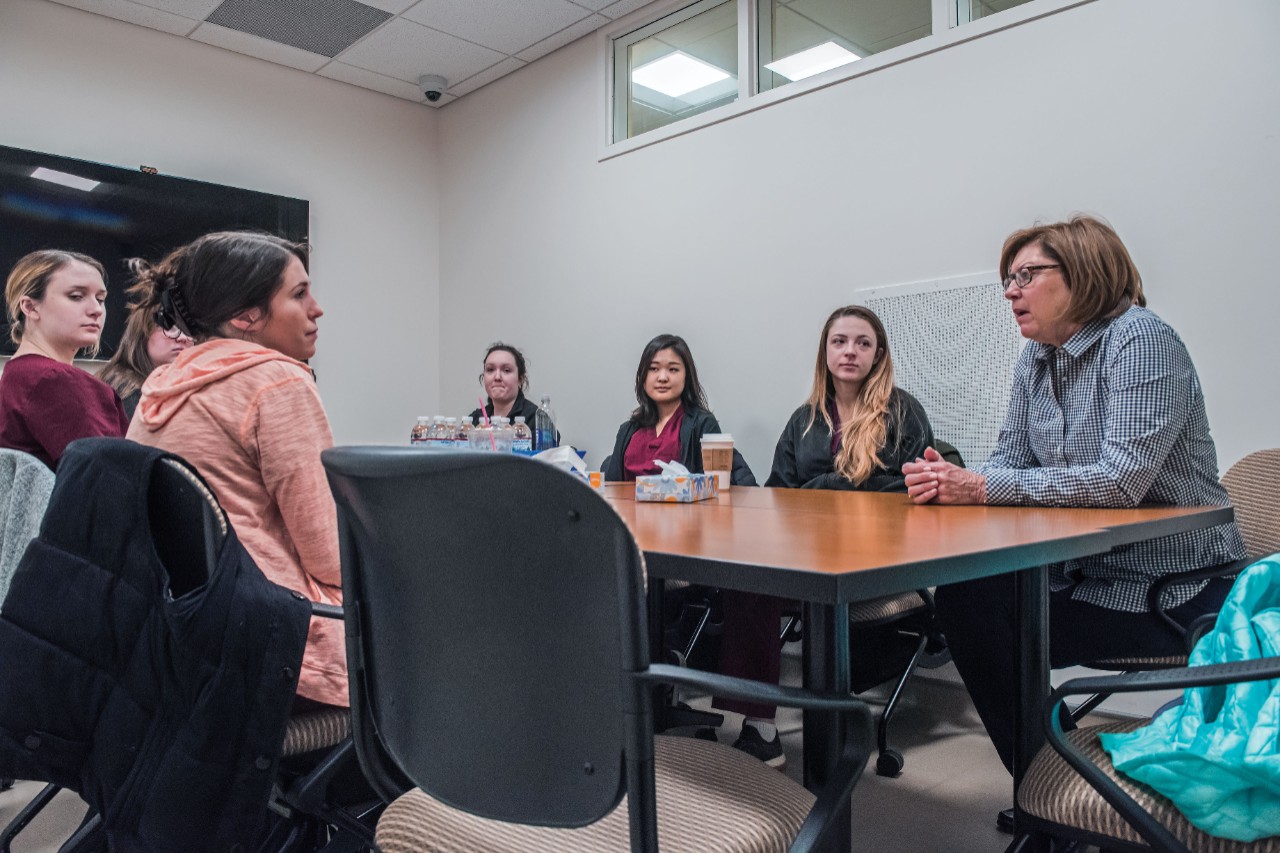
Cullinan (right) debriefs with students
Zlevor, Cullinan, and DeSanto-Madeya lead seven students apiece into small conference rooms, each furnished with a round table and appointed with bowls of candy (Jolly Ranchers, chocolates) and a box of tissues.
DeSanto-Madeya begins by asking students, “What feelings did what you just witnessed evoke?” By Smith’s design, all post-simulation discussions begin this way. “If students don’t get out their emotions first, the learning can shut down,” she says.
Catie Trausch starts to cry. “It was exactly the same as when my mother died,” she says. “But I appreciate being able to see it from a clinical distance now.”
“Don’t take away from your experience,” says DeSanto-Madeya. “It adds to your compassion. If you’re tearing up with the family, it shows you’re with the family.”
For the next 90 minutes, students dissected the behavior of the nurses and family members in the simulation. “How did you feel” about Zlevor saying Marybeth was “a good mother?” asked Desanto-Madeya.
“It was strange because she didn’t know Marybeth,” said Trausch. “We can’t say something because we should. If the patient had had a complicated relationship with her children, that could evoke negative feelings.”
Desanto-Madeya agreed. “What you say should come from a place of knowing. Just as it’s dangerous to project and say, ‘You need to be strong.’ Sometimes the patient is at peace, and wants to let go.”
“People are selfish,” said a student across the table. “They want to keep people in their lives, but can’t accept what the patient wants in the end.”
“And it’s our job as nurses to help the family understand and delicately try to help them to embrace the patient’s wishes,” said Desanto-Madeya.
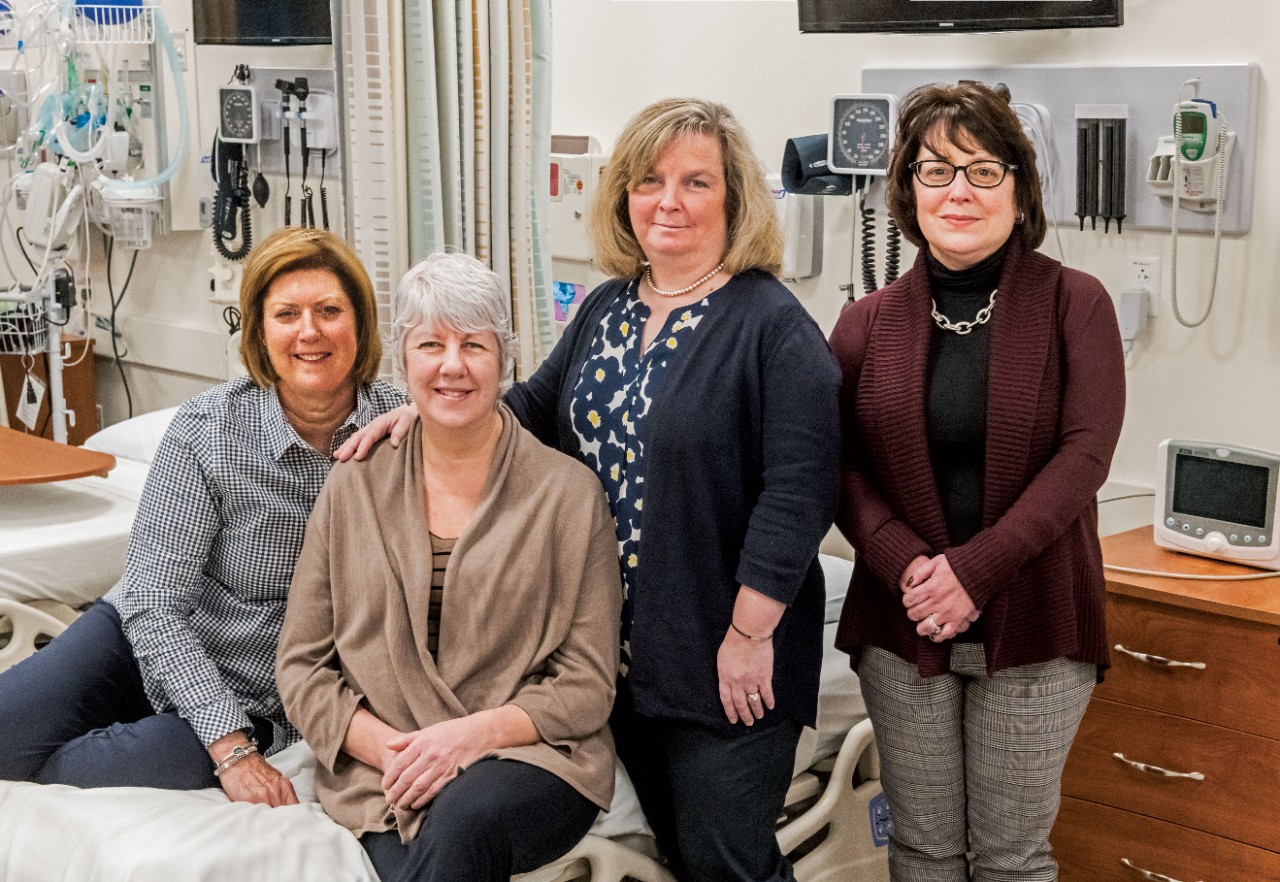
Program developers and staff, from left, Cullinan, Foley-Kass, Smith, and DeSanto-Madeya.
Soon, the questions for Desanto-Madeya came quickly.
What drew you to palliative care?
She began her nursing career in the neuro-trauma intensive care unit, but one patient “awakened” her. A 25-year-old man fell backwards off the deck of a ski lodge, and became a quadriplegic. Eventually, he was weaned off a ventilator, returned home, and began to ride a stationary bike. “By all medical accounts he was doing much better,” she said. But when she called his home a few months after he was discharged, his mother answered, and told Desanto-Madeya that her son had committed suicide. “Socially and psychologically, he wasn’t supported enough,” Desanto-Madeya said. “I wanted to be more attentive.”
What do you do when caring for a dead patient’s body?
“I keep talking to her.” She described how quickly pallor mortis (paleness of skin) and algor mortis (decline of body temperature) set in, how “even if you don’t believe as I do that the soul leaves the body, when death occurs that person is very much just gone. But still, there’s a person before you.”
What do you say?
“I tell them what I’m doing. I’m going to turn you over now. I’m going to wash your feet. Now I’m going to wrap you up. Just keep talking, keep that human interaction.”
At noon, the students departed. The actors and debriefers remained behind in the lab. Over chicken sandwiches and salad, they shared stories of patients who died on their watch, and chatted about traffic on I-93, final exams, and the rabbits who live in caves in the retaining wall between Lower and Middle Campus, which faces the simulation center’s windows. Sullivan is looking better. The makeup has begun to wear off her face, and Foley-Kass has to apply another layer back in the exam room. Marybeth will die in front of a second group of 21 seniors at 12:40.
Dying twice leaves Sullivan “completely drained,” she says, “but it’s invaluable” to give students this “very real yet protected experience.” She adds, “I want students to take away that it’s important to touch somebody who’s dying . . . to continue to speak to them and to let them know that you’re there.”
At the end of the second debrief, a student in Donna Cullinan’s group said that she appreciated witnessing the death and the examples of fastidious and faithful care, “But I still have no idea how I will react when my first patient dies.”
Cullinan, who has witnessed countless patients die in her 30 years as a community health nurse, replied that she still often doesn’t know how she’ll react to death either. “But use the tools you now have to show patients and their families that this is normal. This is the life cycle. Not just by clearly explaining to them the mechanisms of dying—the loss of appetite and circulation—but by listening to their desires and fears. Take comfort in knowing you are a source of comfort.”
Smith would agree. Nurses “will never feel a hundred percent comfortable” with death, she says. But through the End of Life Simulation Program, she hopes students will know that, “when everyone else leaves, we stay in the room.”



